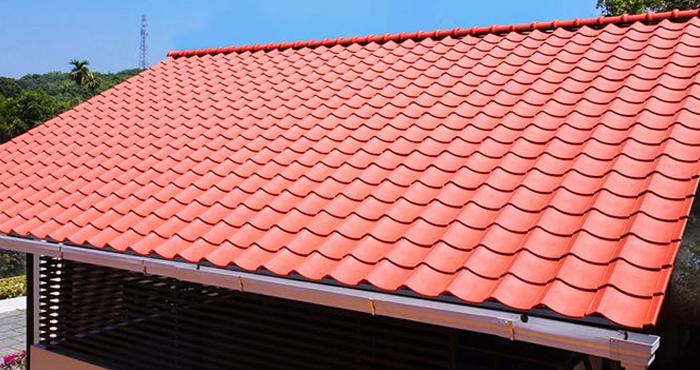Terracotta tiles are a fantastic choice for adding warmth, charm, and a touch of rustic elegance to your home. These beautiful tiles have been used for centuries and come in various types, each with its own unique characteristics.
So, if you are curious to know more about different types of indoor and outdoor terracotta tiles, you have arrived at the right place. In this blog post, we’ll explore different types of terracotta tiles with their advantages, uses, and how to care for them.
What Are Terracotta Tiles?
Terracotta is a form of clay-based ceramic that has been used for thousands of years to make pottery, bricks, and tiles. The word “terracotta” means “baked earth” in Italian. Natural clay is used to make terracotta tiles, which are then formed into tiles and heated in a kiln to produce strong, long-lasting tiles.
Types of Terracotta Tiles

Traditional Terracotta Tiles
Traditional terracotta tiles are the most widely used type. They are typically reddish-brown in colour and have an earthy, rustic appearance. The size, shape, and thickness of these tiles provide you with a variety of design options.
Uses: Traditional terracotta tiles make excellent flooring, particularly for outdoor patios, hallways, and kitchens. They add a cosy and timeless feel to any space.
Care: To keep these tiles in good condition, sweep or clean frequently to stop dirt and other debris from damaging the surface. Avoid using harsh cleansers that can harm the finish, and instead, wash them with a solution of mild detergent and water to clean them.
Saltillo Tiles
Mexican terracotta, often known as saltillo tiles, has an orange or yellow hue and is distinguished by its uneven shapes and imperfections on the surface. These tiles originate from Mexico and are handcrafted.
Uses: Saltillo tiles are excellent for giving your home a Southwestern or Spanish feel. They function nicely in living areas, kitchens, and outdoor settings.
Care: To protect Saltillo tiles from stains and moisture, handle them with a high-quality sealant. To keep them clean, gently sweep or mop with a damp towel.
Quarry Tiles
Unglazed terracotta tiles, known as “quarry tiles,” are often brown or red in colour. They are better suited for high-traffic areas than regular terracotta tiles since they are thicker and more robust.
Uses: Quarry tiles are excellent for commercial spaces, such as restaurants and stores, as well as for home entryways, patios, and walkways.
Care: Clean quarry tiles with a pH-neutral cleaner and reseal them periodically to maintain their appearance and protect against stains.
Glazed Terracotta Tiles
Traditional terracotta tiles with a glossy sheen are known as glazed terracotta tiles. They are a flexible option for interior decor because they are available in a variety of colours and patterns.
Uses: Glazed terracotta tiles are frequently used for accents, backsplashes, and bathroom walls. They provide your house with a splash of colour and sophistication.
Care: Use a moist cloth and a mild detergent to clean glazed terracotta tiles. Do not use rough cleaning chemicals because they can damage the glazing.
How to Care for Terracotta Tiles
Taking proper care of your terracotta tiles will ensure they last for years and maintain their beauty. Here are some essential care tips:
Regular Cleaning
Sweep or vacuum your terracotta tiles regularly to remove dirt and debris. This prevents scratches and keeps the tiles looking clean.
Avoid Harsh Cleaners
Use a mild detergent and water to clean your terracotta tiles. Harsh chemicals can damage the tiles or their glaze, if applicable.
Seal Your Tiles
If your tiles are unglazed, like traditional terracotta or Saltillo tiles, sealing is crucial. Sealing helps prevent stains and makes cleaning easier. Follow the manufacturer’s recommendations for sealing frequency.
Handle Stains Promptly
Accidents happen, and spills can occur. If you spill something on your terracotta tiles, clean it up immediately to prevent stains from setting in.
Avoid Excessive Moisture
Because they are porous, terracotta tiles can absorb moisture. Use rugs or mats in places like the kitchen that are prone to spills and avoid prolonged exposure to water.
Conclusion
Terracotta tiles are a beautiful and versatile choice for your home’s flooring and decor. Whether you prefer the classic look of traditional terracotta, outdoor terracotta tiles, or terracotta clay roof tiles for indoors, there are many options to suit your style.
By following proper care guidelines, you can enjoy the timeless beauty of terracotta tiles for years to come. So, if you are looking to get the best terracotta brick tiles or terracotta floor tiles, Jindal Mechno Bricks are here to help. We are known for providing high-quality building materials that can help you in building your dream home or project. Contact our team today to know more.
FAQs
FAQ 1: Are terracotta tiles suitable for outdoor use?
Answer: Yes, many terracotta tiles—particularly classic and quarry tiles—can be used outside. They have a reputation for being strong and resilient in all kinds of weather.
FAQ 2: Can I install terracotta tiles in a bathroom or kitchen?
Answer: Yes, terracotta tiles can be installed in kitchens and bathrooms. Terracotta tiles with glaze are an excellent choice for these locations since the glaze provides an additional layer of defence against stains and dampness. But it’s crucial to make sure that the sealing and upkeep are done correctly.
FAQ 3: How do I clean and maintain terracotta tiles?
Answer: To maintain and clean terracotta tiles, regularly sweep or vacuum to get rid of dirt and debris. Avoid using rough cleaning agents that can harm the tiles or their finish, and instead, use a solution of mild detergent and water for routine cleaning. If your tiles are unglazed, you might want to seal them to make cleaning easier and prevent stains.
FAQ 4: Can I install terracotta tiles myself, or should I hire a professional?
Answer: If you have tile installation skills, you can install terracotta tiles yourself. However, it’s important to adhere to the right installation procedures, which include making use of the appropriate adhesive, spacing, and grouting methods. If you’re unsure or have a complex installation, it’s advisable to hire a professional tile installer who can ensure a proper and long-lasting installation.





